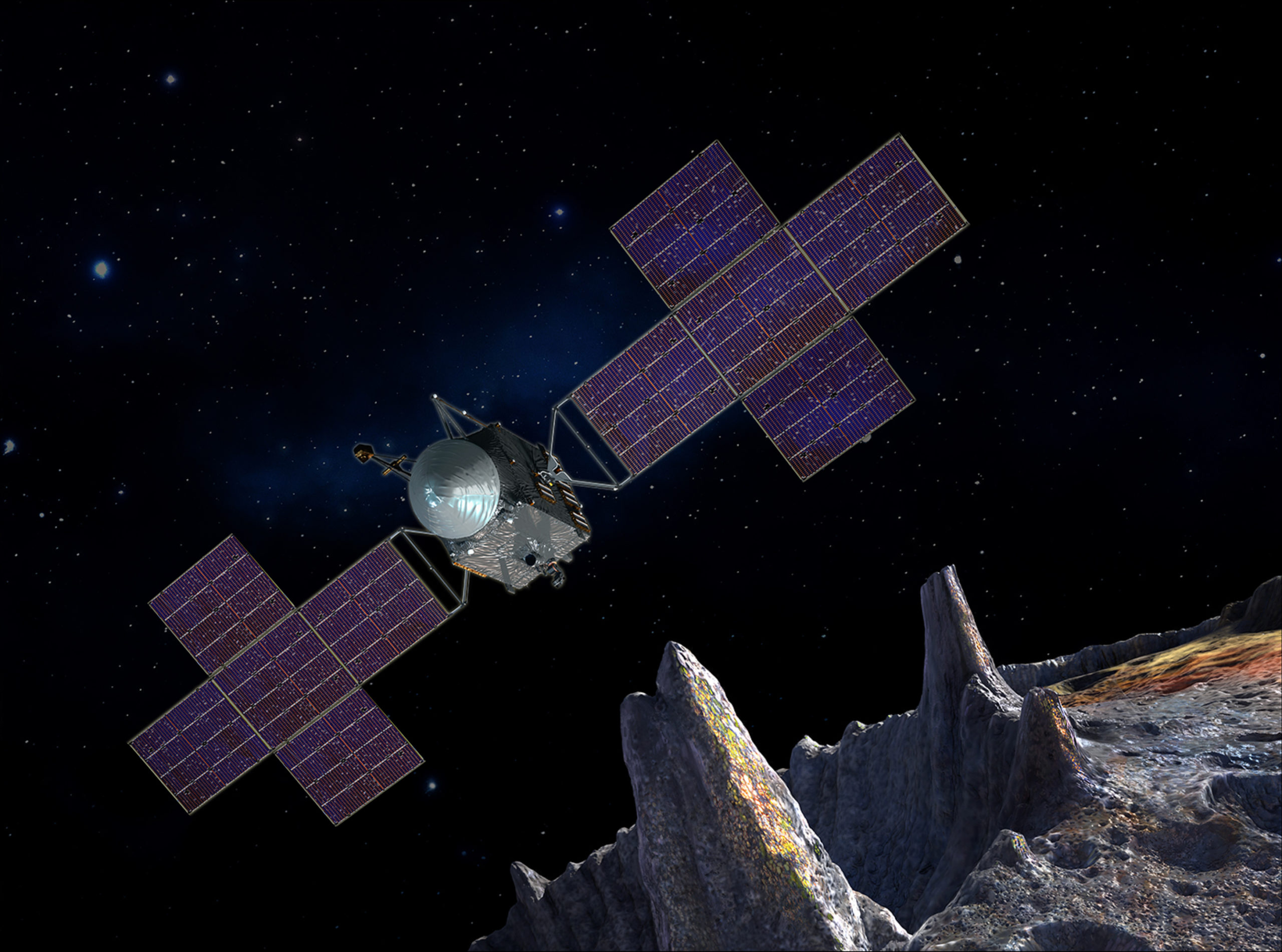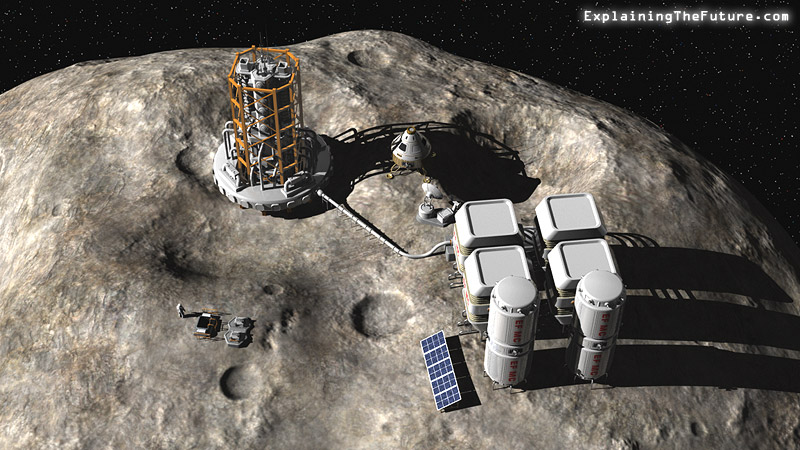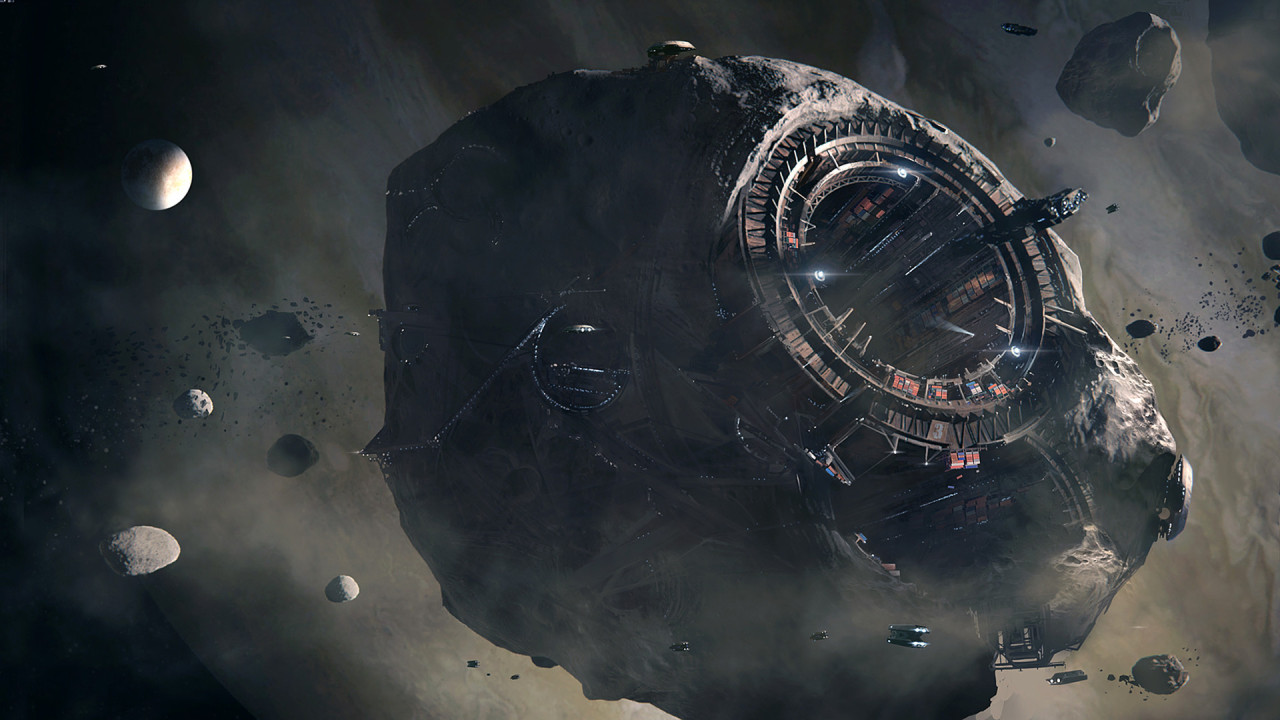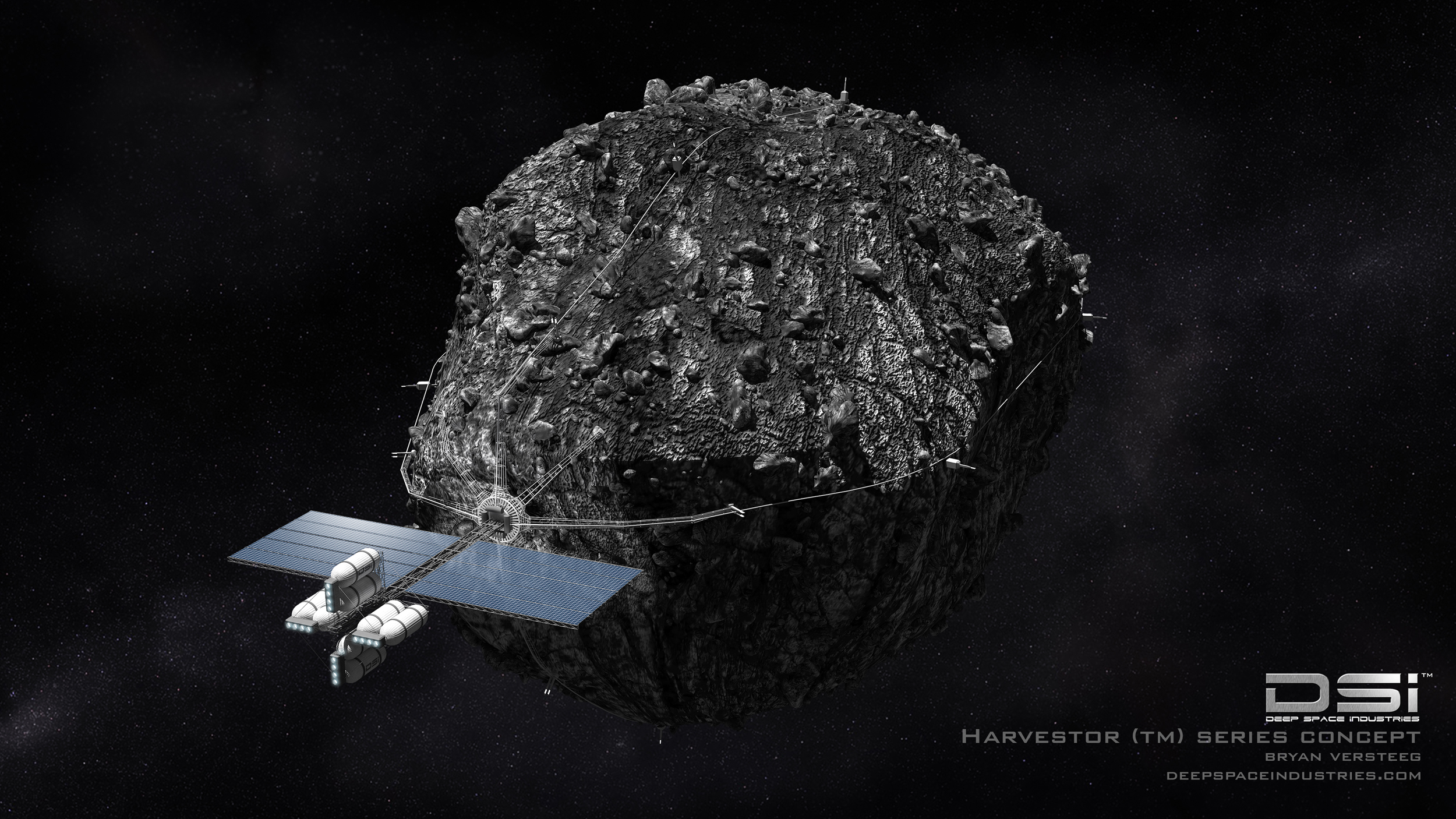
When it comes to their composition and internal structure, there is a wide variety among the asteroids. We know this primarily through two means: the study of the various meteorites that have landed on Earth – the subject of a future “Special Topics” presentation – and examination of their spectrum. Although asteroids do not give off their own light, they reflect light from the sun, and by examining the various features within these spectra we can deduce what materials might be present that are producing these features.
Although several taxonomic classifications for asteroids have now been defined, they essentially come in three broad types: a) those that are primarily made up of silicates, with some metals present – these are the most common; b) those that are primarily made up of metals (primarily iron and nickel, although numerous other metals (including gold– and platinum-group metals) are present as well); and c) the “carbonaceous” asteroids, primarily made up of organic compounds, and also containing a significant amount of water. The nuclei of comets can also be included among this last group.
The largest metallic asteroid was discovered 168 years ago this week – on March 17, 1852 – by the Italian astronomer Annibale de Gasparis from Naples. Now known as (16) Psyche, this asteroid orbits within the main asteroid belt with a period of 5.0 years, and appears to be approximately 225 km in diameter. As a result of a close flyby by a smaller asteroid in 1974, Psyche’s mass, and consequently its overall average density, could be determined; this is approximately 4 gm/cubic cm, and together with spectroscopic studies this indicates a composition roughly 90% metallic iron with smaller amounts of nickel and other metals. It may be the remnant core of a protoplanet from the solar system’s early days, and meanwhile it is the planned destination of NASA’s upcoming Psyche mission, with launch scheduled for July 2022 and arrival planned for late January 2026. Psyche will be at opposition this coming December, and should be near 9th magnitude around that time.
The presence of so much metal in asteroids suggests that they could, in theory, be mined for use here on Earth. Our need of metals in our increasingly technological society correspondingly continues to increase, however the supplies of metals on Earth are finite, and moreover are increasingly difficult to identify and get to. (Most of Earth’s metals are in its core, having settled there during Earth’s formation billions of years ago.) Much of the metals on asteroids, meanwhile, are directly on their surfaces, and thus would be relatively easy to get to and to extract – provided we had the means to get there and to extract those metals in the first place.
Some years ago (now-retired) University of Arizona geologist John Lewis calculated that a metallic asteroid 2 km in diameter contains enough metals to be worth US$20 trillion in today’s economy. On that same scale, the worth of the metal content in large metallic asteroids like Psyche would be numbered in the quadrillions of US dollars.

It isn’t just here on Earth where the resources contained within asteroids can be useful, and the supply of “usable” asteroids isn’t limited to just the metallic ones. Even the primarily-silicate asteroids – which, again, are the most common – contain a non-trivial amount of metals, as well as oxygen and other similar substances. If humanity is ever to develop a space-faring civilization, such materials can be utilized in a variety of ways, from construction of spacecraft to construction and maintenance of colonies on various bodies. The water within carbonaceous asteroids and within comets can be utilized in sustaining human colonies, but can also be dissociated into its constituent hydrogen and oxygen for usage as fuel for rockets and other machinery.
For any such future to take place, of course, this process must be economically feasible, and requires the development of a substantial infrastructure. In theory, there are several ways that the extraction of resources from asteroids and comets can proceed; probably the most obvious is on-site human operations, which however would also be the most expensive as it involves not only the development and transport of the on-site extraction machinery but also the life-support mechanisms for the human crews during transport and operations. The need for and expense of these life-support mechanisms is alleviated if the mining operations are autonomous, although this in turn would require the development of the appropriate artificial intelligence (AI) technology such that operations could proceed in a manner that requires little human interaction.
A somewhat alternative approach involves not traveling out far distances to asteroids to perform mining operations, but rather bringing them to Earth’s vicinity where the mining can then be performed. For the near- and intermediate-term future, this limits us to near-Earth asteroids, however – as has been addressed in previous “Special Topics” presentations – there are still large numbers of these, quite a few of which are metallic and others of which are carbonaceous. The effort and expenses involved would also limit near-term efforts to very small asteroids, but even these still contain enough in the way of resources so as to make extraction efforts seemingly worthwhile.
Indeed, regardless of whatever approaches humanity might eventually deem as most appropriate, the earliest resource extraction efforts will almost certainly focus on near-Earth asteroids. In celestial mechanics, the most important quantity is “Delta_V,” i.e., the changes in velocity necessary to make rendezvous and landing operations possible. The Earth already has a certain orbital velocity (roughly 30 km/sec) and once a spacecraft has climbed out of Earth’s gravity well – a process that itself requires a substantial Delta_V – it then possesses that same velocity. In order to rendezvous with, and potentially land upon, another body, the spacecraft needs to match velocities with that other body. This requires energy, which in turn requires fuel, and from an economic perspective, this in turn requires money.

To travel to, and potentially perform mining operations upon – and/or to bring back to Earth’s vicinity – any asteroid, we need to find asteroids that require a minimum of Delta_V. What we would need, then, are asteroids that are traveling in near-circular orbits the same approximate size as Earth’s orbit, and that have very small orbital inclinations with respect to Earth’s orbit. As it turns out, a number of near-Earth asteroids have in fact been identified that have smaller Delta_V requirements than does travel to the moon. If we wish to travel to and retrieve such objects so as to bring them to Earth’s vicinity, then we need these asteroids to be quite small; there are indeed a number of such objects, although here the primary difficulty involves detecting them in the first place. In 2013 Daniel Garcia Yarnoz and his colleagues at the University of Strathclyde in Glasgow, Scotland examined the various near-Earth asteroids that were known at that time and published a list of the top dozen “easily retrievable objects.” These are all small objects – no more that a few meters in diameter – and the orbits of some of them are not especially well known, in fact only one has been observed since the publication of the list. Nevertheless, especially with the surveys that are presently operating, new candidate objects are being discovered fairly frequently.
This entire process was the aim of NASA’s planned Asteroid Redirect Mission (ARM), proposed in 2013. Although the primarily purpose of ARM involved deflection strategies for potential incoming near-Earth asteroids – which itself is the topic of a future “Special Topics presentation – the procedures would also be applicable to potential resource extraction efforts. Had ARM proceeded as planned the mission – human-crewed – would have launched in late 2021, but it was cancelled in 2017.
In addition to the engineering and the economic issues involved, another facet that enters into the discussion of asteroid/comet resource extraction involves space law. Any such operations would, in theory anyway, be subject to international agreements and treaties, in a manner, for example, that activities on Earth’s oceans are governed by the United Nations Convention of the Law of the Sea. In space, the primary governing document is the “Treaty on Principles Governing the Activities of States in The Exploration and Use of Outer Space, including the Moon and Other Celestial Bodies” – generally referred to as the “Outer Space Treaty” – that became effective in 1967. The Outer Space Treaty prohibits signatory nations from claiming any celestial object, or portion thereof, as its own national territory, however – although the wording is not explicit – it has been interpreted to mean that private entities can extract materials from these bodies for various usages.
Some nations have gone further. In the U.S., Congress passed the U.S. Commercial Space Launch Competitiveness Act in 2015 which was then signed into law by then-President Barack Obama, and which among other things allowed and encouraged the commercial utilization of resources from asteroids. Luxembourg passed similar legislation two years later, and during forthcoming years, especially as the prospect of asteroid mining becomes more of a reality, we might expect that other nations would follow suit.

A private company that wishes to explore the process of asteroid mining would seemingly face daunting challenges. The investments involved in developing the necessary infrastructure would be enormous, and many years, conceivably decades, might elapse before there could be any significant return on those investments. In such an environment, the most likely scenario would seem to be some sort of public-private partnerships involving governmental agencies like NASA and other national (or international, in the case of ESA) space agencies, although even here funding is subject to considerations of what the respective publics might be willing to invest. In the long run, however, if the effort can be maintained and the necessary infrastructure can be developed, the potential rewards are enormous; there are at present studies that have been performed and which indicate the net worth of potential operations on various known asteroids; even some of the near-Earth asteroids have a net worth of a few hundred billion to a few trillion US dollars, and some of the main-belt asteroids have a net worth of “hundreds of trillions” of US dollars.
The first preliminary efforts towards such a future have already begun. The firm Planetary Resources, co-founded in 2009 by space entrepreneurs Peter Diamandis (founder of the X-Prize) and Eric Anderson (CEO of the firm Space Adventures) with the goal of developing a resource extraction program, has launched a couple of small proof-of-concept satellites (Arkyd 3 Reflight, deployed from the International Space Station in 2015, and Arkyd 6, launched in 2018. Initially, Planetary Resources planned to devote its primary efforts towards finding near-Earth objects that contain significant amounts of water that can then be utilized as rocket fuel., however in late 2018 it was acquired by the firm ConsenSys and those efforts have since been de-emphasized. A similar company, Deep Space Industries, was founded in 2013 by, among others, long-time commercial space advocate Rick Tumlinson, and in fact I served on its Board of Advisors, however DSI was acquired by Bradford Space, Inc. at the beginning of 2019 and its originally planned efforts towards resource extraction from asteroids/comets are on hold for at least the time being.
To adopt a long-range view, if humanity is ever to expand into the solar system beyond Earth’s vicinity, it will need to develop a “live-off-the-land” mindset and infrastructure that will certainly need to include the extraction of necessary resources from the bodies that are out there, most definitely including asteroids and comets. The challenges are enormous and the necessary investments – financial and otherwise – are large, but the eventual payoffs from these would involve nothing less than the survival and growth of humanity. I would like to think that some of the “Ice and Stone 2020” participants might one day be involved in endeavors such as these.
More from Week 12:
This Week in History Comet of the Week Free PDF Download Glossary
Ice and Stone 2020 Home Page


